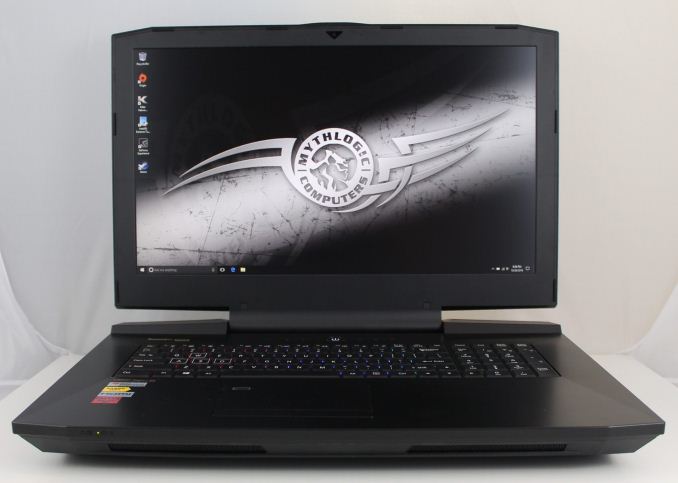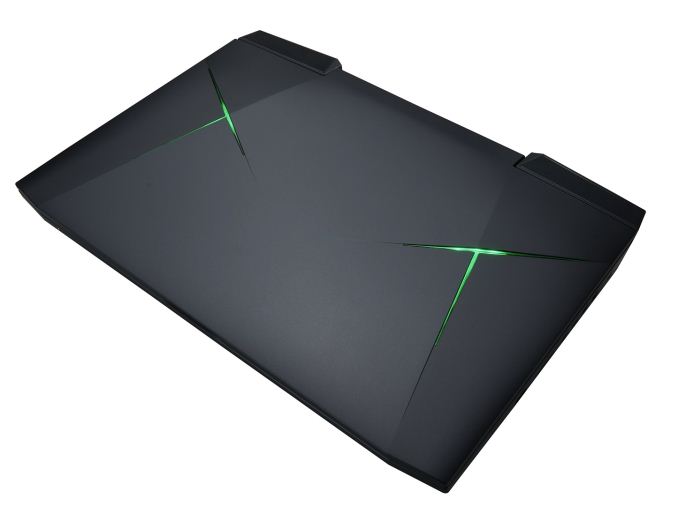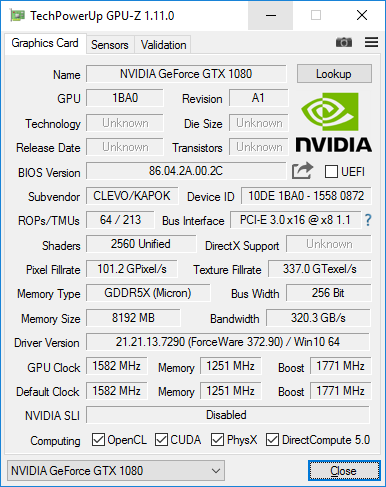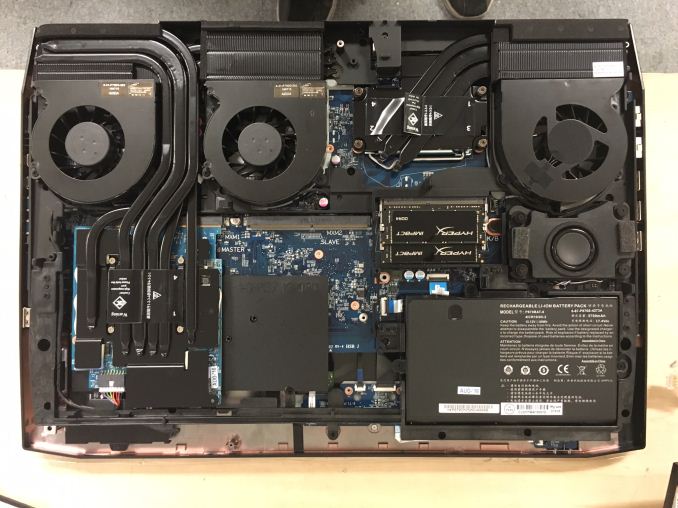The Clevo P870DM2 / Mythlogic Phobos 8716 Laptop Review: DTR With GTX 1080
by Brett Howse on October 27, 2016 2:00 PM EST
Sometimes there is no substitute for performance. Most of the laptop market is focusing on thin and light designs, with companies attempting to outdo each other by shaving a millimeter or two off of their laptop z-height compared to the competition. But in the Desktop Replacement (DTR) category, there are no such concessions. Clevo is one of the few laptop makers that is in the DTR market, and thanks to the assistance of Mythlogic, we have the Mythlogic Phobos 8716 DTR for review today. As a Clevo, the model would be P870DM2.
Let’s cut right to the chase. The Mythlogic Phobos 8716 is a beast of a laptop, and really should rarely be used in your lap. It is designed for someone who needs the ultimate performance, but still needs something more portable than a full desktop. This is a 17.3-inch display packed into a chassis that is 47.2 mm thick (1.86”) and weighs in at 5.5 kg (12.13 lbs) with a single GPU. And yes, you can opt for two GPUs, which ups the weight and moves you into the land of ridiculous.
Mythlogic offers a couple of choices of CPU and GPU, but all the CPUs are desktop parts, from the Intel Core i5-6400 65-Watt processor up to the Intel Core i7-6700K 91-Watt processor (as we have in the review unit). This is the same unlocked quad-core as you would find in any high performance desktop. On the GPU side, the base model is a mere GTX 1070, or step up to the GTX 1080, or either card in SLI. If you get dual GTX 1080 GPUs, be prepared to have two AC outlets handy for the dual 330-Watt AC Adapters. Mythlogic also supports overclocking on all of the components. There are four SODIMM slots for up to 64 GB of DDR4 memory as well. This is well and truly a desktop class computer packed into a (somewhat) portable chassis.
The display options also need mentioning too. The standard panel is a 1920x1080 IPS display with a 120 Hz refresh rate. That should be a very significant upgrade for almost anyone, up from the ubiquitous 60 Hz laptop displays. They are also offering a 2560x1440 AHVA 120 Hz panel with G-SYNC option, and a 3840x2160 60 Hz AVHA panel which also includes G-SYNC.
| Mythlogic Phobos 8716 / Clevo P870DM2 | |
| As Tested: 6700K, 16GB (2x8) 2400 DDR4, 1x1080, 256GB Samsung 950 Pro m.2, 120Hz FHD, $2980 USD |
|
| CPU | Intel Core i5-6400, 4C/4T, 2.7-3.3 GHz, 6MB Cache, 65W TDP |
| Intel Core i5-6500, 4C/4T, 3.2-3.6 GHz, 6MB Cache, 65W TDP | |
| Intel Core i5-6600, 4C/4T, 3.3-3.9 GHz, 6MB Cache, 65W TDP | |
| Intel Core i5-6600K, 4C/4T, 3.5-3.9 GHz, 6MB Cache, 91W TDP | |
| Intel Core i7-6700, 4C/8T, 3.4-4.0 GHz, 8MB Cache, 65W TDP | |
| Intel Core i7-6700k, 4C/8T, 4.0-4.2 GHz, 8MB Cache, 91W TDP | |
| GPU | NVIDIA GTX 1070 8GB, 2048 CUDA Cores , 1442 - 1645 (Boost) MHz Also available as 2 x SLI |
| NVIDIA GTX 1080 8GB, 2560 CUDA Cores, 1556 - 1733 (Boost) MHz Also available as 2 x SLI |
|
| Memory | 4 SODIMM Slots, 64 GB Max, up to 3000 MHz |
| Display | 17.3" 1920x1080 IPS 120Hz Optional 2560x1440 AHVA 120 Hz w/G-SYNC Optional 3840x2160 AHVA 100% Adobe RGB w/G-SYNC |
| Storage | 2 x 9.5mm 2.5” SATA 2 x m.2 Slot (SATA or 4xPCIE) |
| I/O | 5 x USB 3.0 Ports (1 x powered USB port, AC/DC) 2 x USB 3.1 / Thunderbolt 3 Port (Type-C) 1 x HDMI 2.0 output Port (with HDCP) 2 x DisplayPort 1.3 output Ports SD Card Slot 1 x Headphone Jack 1 x Microphone Jack 1 x Line-in Jack 1 x S/PDIF (digital) (Shared with headphone jack) 2 x Killer E2400 RJ-45 LAN (10/100/1000Mbps) |
| Dimensions | 428 x 308 x 47.2 mm 16.85 x 12.12 x 1.86 inches |
| Weight | 5.5 kg / 12.13 lbs (single GPU) |
| Battery | 82 Wh, 330W / 230W W AC Adapter |
| Wireless | Intel Dual Band Wireless-AC8260 2x2:2 with Bluetooth 4.1 Killer Wireless-AC 1535 2x2:2 with Bluetooth 4.1 |
| Price | $2255 - $5000+ |
There is no shortage of ports, with five USB 3.0 ports, two USB 3.1 Type-C ports with Thunderbolt 3, HDMI 2.0, two DisplayPort 1.3, and separate audio jacks for the headphone, microphone, and line-in. It also features a Killer E2400 Ethernet adapter, and that wired connection can be paired with either the Killer 1535-AC wireless to support Killer’s DoubleShot Pro, or Intel’s Dual Band Wireless-AC 8260 card if you prefer their solution.
With a starting price of $2255, the Mythlogic Phobos could never be considered inexpensive, but on the performance per dollar metric, there are few laptops that offer this kind of performance period, let alone for the price.













61 Comments
View All Comments
ZeDestructor - Thursday, October 27, 2016 - link
Picture of the innards clearly shows one MXM module populated with an empty slot for a second MXM module. With two MXM cards installed, the heatsink for each GPU is shrunk by half though (second card takes over the second fan and gimps the first card to only having the leftmost fan), so there will be a lower boost max.Glaurung - Thursday, October 27, 2016 - link
"Let's be real, you aren't moving this thing around. Just buy a desktop."A laptop takes up much less room than a desktop, and you can close the lid and stow it away in a drawer. Whereas a desktop is always going to be hogging space on your desk for its keyboard, mouse, and monitor. For someone with a small apartment or student dorm room, the ability to simply close the lid and stow the whole thing away is a huge benefit. Don't think of this as a battery powered portable computer, think of it as a compact, stowable computer that has a built in UPS.
andychow - Thursday, October 27, 2016 - link
While I agree with the statement that many buy laptops to be able to stow the thing away, this is a $2255-$5000 device. It's not something I would imagine people in small apartments or dorms would get. Then again, I see "poor" students with macbook pros all the time. You have a good point actually.nerd1 - Sunday, October 30, 2016 - link
Many students I know pay >70k for just tution and rent. $2500 laptop is not that expensive in that regard (especially compared to macbook pros with the same price range)Morawka - Thursday, October 27, 2016 - link
12 pounds for that model, its still a lot easier than lugging around a tower, monitor, cables, etc..this is a great mobile VR Rig.a
DanNeely - Thursday, October 27, 2016 - link
Do you have any power usage figures? I'm curious what the TDP for the mobile version of pascal is. A Desktop 1080 is 180W, did manage to knock 80W of the mobile card to match the outgoing 980m despite only dropping the clock rate a few percent (massive binning???), or is near desktop performance equivalence coming at a huge expansion in power consumption?BrokenCrayons - Thursday, October 27, 2016 - link
You can do some quick estimations based on the fact that the SLI version requires two 330W power supplies.Add to it the cooling configuration of six heat pipes and two radiators...but we need to go back a bit to older tech for the heat pipes. A Dell Latitude D630 with an Intel x3100 GPU has a single heat pipe for the chipset and 35W processor's cooling needs. Assuming the pipe design is better means that a single heat pipe can likely handle 45W total TDP and that's a pretty reasonable estimate, but let's be conservative and say one pipe can deal with only 30W TDP. 30 x 6 pretty much means 180W TDP for the mobile part. Take into account the GPU can't sustain a full load at its highest clock even with all that cooling capacity and I think we're looking at a mobile GPU with the same TDP as the desktop part. There's certainly a lot of compelling evidence pointing that way anyhow.
DanNeely - Thursday, October 27, 2016 - link
Full desktop power is certainly possible, but the need for a second power brick doesn't prove much beyond >~110W. 90 (CPU) + 30 (everything else) + 2x110 = 340W which would max out the 330W power brick.I don't think your handwaving with the heatpipe count argument holds any strength, the size of the heatsinks on the other end, the power of the fans, and what temperatures are considered acceptable puts too much variation to try and assign an N Watts capacity to a single pipe and scale off of that.
BrokenCrayons - Thursday, October 27, 2016 - link
It's all extremely rough estimation on my part and I admit readily it's rife with possible faulty thinking and off-the-cuff guesswork, but unless or until we get credible numbers either from NV directly or from a group equipped to perform accurate analytics, there's nothing left but idle speculation...which can be sort of fun in its own way even if it ends up being way off the mark.Brett Howse - Thursday, October 27, 2016 - link
Please don't forget that this also supports overclocking, so they have to supply a big enough power adapter to avoid running out of headroom when overclocking, so you can't really make the assumptions you are.NVIDIA doesn't have formal TDP numbers for the mobile parts, but they are going to be somewhere under the desktop ones.